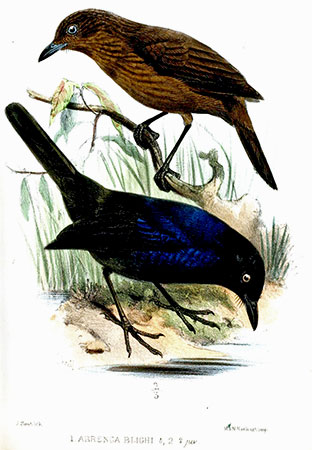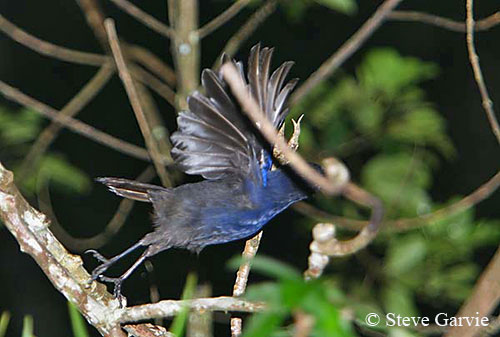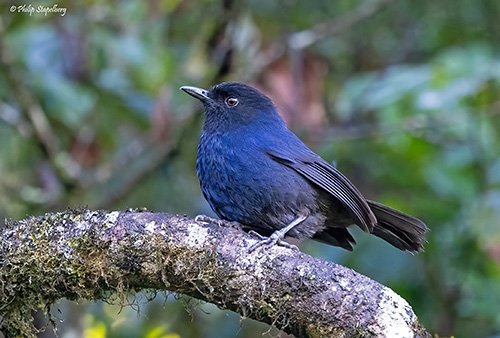
PROTECTION / THREATS / STATUS:
The Sri Lanka Whistling Thrush has declined in recent years, probably as the result of extensive clearance and degradation of montane forest for agriculture expansion. Gem mining is also a serious threat, because this activity is concentrated in the favoured habitat of this species. Degradation and fragmentation of forests is continuing. Monoculture plantations have replaced the natural forests, involving lack of food. Streams are polluted by vegetable farms.
The population is estimated to number 667/1,666 mature individuals, rounded to 600/1,700 mature individuals. It is suspected to be declining.
The Sri Lanka Whistling Thrush is currently listed as Endangered.
Fr: Arrenga de Ceylan
Ang: Ceylon Whistling-Thrush - Sri Lanka Whistling Thrush
All: Ceylonpfeifdrossel
Esp: Arrenga de Ceilán
Ita: Tordo fischiatore di Sri Lanka
Nd: Ceylonfluitlijster
Sd: ceylonvisseltrast
Photographers:
Steve Garvie
RAINBIRDER Photo galleries
Philip Stapelberg
GALLERY
Alan & Ann Tate
AA Bird Photography
Illustration:
Joseph Smit: 1836-1929
Source of the illustration:
Proceedings of the Zoological Society of London (vol. 1872, plate XIX)
https://archive.org/details/proceedingsofgen72zool/page/n461/mode/2up
Text by Nicole Bouglouan
Sources:
HANDBOOK OF THE BIRDS OF THE WORLD Vol 10 by Josep del Hoyo-Andrew Elliott-David Christie - Lynx Edicions - ISBN: 8487334725
THRUSHES by Peter Clement and Ren Hathway – HELM - ISBN: 0713639407
The World's Rarest Birds De Erik Hirschfeld, Andy Swash, Robert Still – Editeur: Princeton University Press, 2013 – ISBN: 1400844908, 9781400844906 – 360 pages
The endangered Sri Lanka Whistling Thrush Myophonus blighi eats an endangered lizard
SUNDAY OBSERVER.lk - Rare Lankan bird in danger of extinction
Sundaytimes.lk - In search of a whistle in the wilds
Wikipedia, the free encyclopaedia
Page Order Passeriformes
Summary cards
Sri Lanka Whistling Thrush
Myophonus blighi
Passeriformes Order – Muscicapidae Family
INTRODUCTION:
The Sri Lanka Whistling Thrush is endemic to Sri Lanka where it is resident.
It is found close to running streams in deep forest, and often in wooded ravines, between 1,200 and 2,100 metres of elevation. It feeds on a wide range of food items including insects, frogs, earthworms and berries. It can be seen foraging on the ground, often close to water.
This species builds a large, compact nest on rock ledge or in tree fork, near to waterfalls or rapids. They are monogamous and the territory is maintained by the pair all year-round.
The Sri Lanka Whistling Thrush is a scarce, shy, secretive and terrestrial bird.
It is threatened by habitat loss and human activities in its favoured habitats, involving reduction of food supply.
The Sri Lanka Whistling Thrush is currently listed as Endangered.
DESCRIPTION OF THE BIRD:
Biometrics:
Length: 19 – 21,5 cm
The Sri Lanka Whistling Thrush male has upper and underparts deep blue-black with bluish sheen in strong light. Rump, uppertail-coverts, tail and flight-feathers are black to sooty-black.
On the upperwing, the lesser coverts are bright cobalt-blue, forming a shoulder patch, sometimes concealed. Median and greater coverts are black with blue-black edges to greater coverts. Alula, primary coverts and flight-feathers are black. Primary coverts, inner primaries and secondaries show blue-black edges.
On the underparts, underwing-coverts, lower belly, vent and undertail-coverts are sooty-black.
The head is entirely black.
The bill is black, with slightly hooked tip to upper mandible.
The eyes are dark brown.
Legs and feet are dark brown to blackish.

Joseph Smit: 1836-1929
Adult male and immature female
The female has head and underparts rufescent-brown to chestnut-brown.
On the upperparts, mantle and scapulars show deep purplish-blue sheen. She also has a purplish-blue patch at the bend of the wing. Rump and uppertail-coverts are cinnamon-brown. Flight-feathers and rectrices are dark brown.
On the brown head, lower forehead and face are warmer brown or slightly paler than the crown. Chin and throat are pale brown. Rest of underparts is slightly darker brown.
The immature resembles female but the underparts are slightly paler or warmer rusty-brown than in adults. Head and breast show narrow buff streaking.
The first year male shows deep, bluish bases to head, breast and belly feathers. The lesser coverts become bright blue within the first six months.
RANGE:
The Sri Lanka Whistling Thrush is found in the central mountains and Uva province in Sri Lanka.
HABITAT:
The Sri Lanka Whistling Thrush frequents the undergrowth of damp, dense forest and wooded ravines and gorges covered in ferns. There, it remains mostly within or beneath low, overhanging rocks and vegetation on the river banks. It is often observed near rapid, flowing water and streams.
The species is visible between 1,200 and 2,100 metres of elevation.
CALLS AND SONGS: SOUNDS BY XENO-CANTO
The call of the Sri Lanka Whistling Thrush is a shrill, high-pitched whistle given in flight or from the ground. This call may be restricted to the first syllable given every few seconds “sriii” and sometimes as a double note “seer eer”. This call is often heard above the noise of the running water. Both adults give this call.
The song is rarely heard. It is described as a drawn-out, plaintive whistling note.
During the displays, the male gives a short, undulating, high-pitched whistle, sometimes preceded by series of shrill warbling notes. In territory defence, we can hear a scolding song composed of high-pitched notes.
BEHAVIOUR IN THE WILD:
The Sri Lanka Whistling Thrush feeds mainly on insects, snails, small frogs, lizards, geckos, and occasionally ripe fruits and berries.
It usually forages on the ground, often near water.
Although being shy and secretive, the Sri Lanka Whistling Thrush is very active while searching for food, and especially at dusk and dawn. It forages in and under the vegetation, also in damp hollows and at the edges of streams and ponds. It hops and runs quickly while spreading the tail. But it may also sit motionless for long periods.
They usually roost communally in trees, at the territory’s boundaries.
They live in pairs, remaining and defending year-round their territory. The female builds a large, cup-shaped nest on rocky ledge or among rock crevices, near river or torrent, or sometimes in tree fork, up to 3 metres above the ground. During this work the male remains in the surrounding, but does not take part in nest-building. The female incubates alone, but both parents feed the chicks.
The Sri Lanka Whistling Thrush is probably sedentary.
The flight is fast and generally low. The bird can be observed in the evening, flying about over and around fast-flowing water while uttering its shrill whistle “sree…ree”.

REPRODUCTION OF THIS SPECIES:
The breeding season of the Sri Lanka Whistling Thrush takes place from January to May and September.
The nest is often placed near running water, and some observations describe the nest-site in the rocky sides of mountain streams. But it may also be placed on a ledge, or among rocky crevices, and occasionally in tree fork, up to 3 metres above the ground.
The nest is a compact, cup-shaped structure made of green moss, plant stems and decaying leaves. The cup is lined with fine, black fern rootlets.
The nest-building by the female may last up to 3 weeks. The male remains in the vicinity of the nest-site, but it does not take part in nest-building.
The female lays 1-2 pale, greenish-white eggs with some faint reddish-brown markings at the larger end. She incubates alone, but the duration of this period is unknown. The chicks are fed by both parents carrying frogs, lizards and insects. The chicks leave the nest 19 days after hatching.
